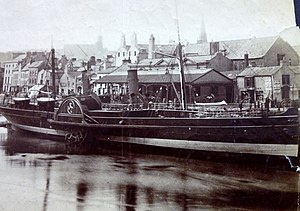 Snaefell pictured berthed in Douglas. Snaefell pictured berthed in Douglas.
| |
| History | |
|---|---|
| Name | Snaefell |
| Namesake | Snaefell |
| Owner | 1863–1875: IOMSPCo. 1875–1888: Royal Netherlands Steamship Company. |
| Operator | 1863–1875: IOMSPCo. 1875–1888: Royal Netherlands Steamship Company. |
| Port of registry | |
| Builder | Caird & Co. Greenock |
| Cost | £22,000 |
| Yard number | 45468 |
| Launched | 22 May 1863 |
| Completed | 1863 |
| In service | 1863 |
| Out of service | 1875 |
| Identification |
|
| Fate | Sold to Royal Netherlands Steamship Company in 1875. Finally sold for scrap in 1888. |
| General characteristics | |
| Type | Paddle steamer |
| Tonnage | 700 gross register tons (GRT) |
| Length | 236 feet (72 m) |
| Beam | 26 feet (7.9 m) |
| Depth | 14 feet (4.3 m) |
| Ice class | N/A |
| Installed power | 1,300 shp (970 kW) |
| Propulsion | Two-cylinder oscillating engines working at 25 pounds per square inch (170 kPa), producing an indicated horsepower of approximately 1,300 shp (970 kW) |
| Speed | 15 knots (28 km/h; 17 mph) |
SS (RMS) Snaefell (I) – the first ship in the Company's history to bear the name – was an iron paddle steamer that served with the Isle of Man Steam Packet Company until she was sold in 1875.
Construction and dimensions
Snaefell was the first of three similar vessels to be built for the Company by Caird & Co. of Greenock. Costing £22,000, she entered service in 1863.
Length 236'; beam 26'; depth 14'. Snaefell had a registered tonnage of 700 GRT.
All three sisters – Snaefell, Douglas and Tynwald were driven by two-cylinder oscillating engines with in the case of Snaefell, a nominal horsepower of 240, producing an indicated horsepower of approximately 1,300.
Snaefell was reboilered in 1869 for £3,500 (equivalent to £408,375 in 2023).
Service life

Snaefell was considered fast for her day, and had a service speed of 15 knots (28 km/h; 17 mph). She reduced the passage time from Douglas – Liverpool to 4hrs 20mins, suggesting a service speed of approximately 17 knots (31 km/h; 20 mph).
On 19 September 1863, Snaefell collided with the Mersey Flat Mary Agnes at Liverpool. Mary Agnes sank with the loss of two lives. Survivors were rescued by HMS Warrior. On 20 October 1864, she collided with the steamship Hibernia at Liverpool whilst bound for Douglas. Severely damaged and flooded at the bows, she put back to Liverpool.
She ran aground at Liverpool on 22 June 1871, after which her Master, Capt. Corlett tendered his resignation. The Company's shareholders asked the board to reappoint him, but after much discussion the board declined. Capt. Thomas Lewis was given command at a salary of £225 (equivalent to £26,462 in 2023) a year, reduced to half pay during lay up.
Disposal
After only 12 years with the Manx fleet, Snaefell was put up for sale. She was sold to the Royal Netherlands Steamship Company of Amsterdam for £15,500 (equivalent to £1,844,398 in 2023) in 1875. She was renamed the Stad Breda and plied between Sheerness and Flushing. In 1888, she was sold for scrapping.
References
- Ships of the Isle of Man Steam Packet Company (Fred Henry) p.66
- Ships of the Isle of Man Steam Packet Company (Fred Henry, 1973) p.64
- Ships of the Isle of Man Steam Packet Company (Fred Henry, 1973) p.64
- "Collision and Loss of Life". Caledonian Mercury. No. 23155. Edinburgh. 22 September 1863.
- "Mercantile Ship News". The Standard. No. 12544. London. 22 October 1864. p. 7.
- "Narrow Escape of the Manx Steamer Snaefell". Liverpool Mercury. No. 7307. Liverpool. 24 June 1871.
- Bibliography
- Chappell, Connery (1980). Island Lifeline T.Stephenson & Sons Ltd ISBN 0-901314-20-X
| Shipwrecks and maritime incidents in 1871 | |
|---|---|
| Shipwrecks |
|
| Other incidents |
|
- Passenger ships of the United Kingdom
- Ships of the Isle of Man Steam Packet Company
- Steamships
- 1863 ships
- Paddle steamers of the United Kingdom
- Ferries of the Isle of Man
- Steamships of the United Kingdom
- Merchant ships of the United Kingdom
- Maritime incidents in October 1864
- Maritime incidents in June 1871
- Ships built on the River Clyde

